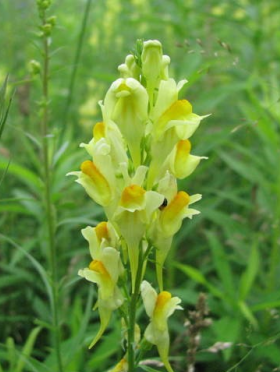Linaria vulgaris
Yellow Toadflax
Synonyms: Linaria linaria
Class: Magnoliopsida
Order: Scrophulariales
Family: Scrophulariaceae

Photographer: Les Mehrhoff
Source: http://www.discoverlife.org/mp/20p?see=I_LJM10552&res=640
Description
Yellow toadflax is a perennial flowing plant that has yellow/orange snapdragon-like flowers. The leaves are lance-shaped, soft and pale green. Mature yellow toadflazx plants grow up to 2 feet tall with 1-25 tall floral stems. The flowers occur in clus Seeds are brown or black, circular and surrounded by a notched wing.
Ecological Threat: Linaria vulgaris is an aggressive invader, disturbing communities from rangelands to riparian communities to roadside and graded areas. It has been listed on the Noxious Weed list for 30 years in over ten states. The problem with this plant is that, once established, yellow toadflax suppresses other vegetation mainly by intense competition for limited soil water. Mature plants are particularly competitive with winter annuals and shallow-rooted perennials. On rangelands, an invasion of yellow toadflax alters the species composition of natural communities and reducing forage production for livestock and wildlife. This in turn reduces rangeland value and can lead to erosion problems.
Biology: Spring emergence occurs around mid-April and depends primarily on temperature. A smaller fall flush of seedlings can occur in the fall. The strong, upright floral stems that are characteristic of mature toadflax plants develop after a winter’s dormancy, and emerge about the same time as seedlings in mid-April. Flowering occurs from May through August and seeds mature from July through October. Yellow toadflax is cannot be self-fertilized so it relies on insects for pollination; especially bumblebees and halictid bees.
Yellow toadflax can reproduce both by seeds (up to 30,000 seeds annually) and vegetatively. Vegetative reproduction enables a stand of toadflax to spread rapidly. Winged seeds aid wind dispersal but seeds may also be dispersed by water and ants. Stems develop from adventitious buds on primary and lateral roots. These buds can grow their own root and shoot system, and become independent plants the next year. Thankfully, yellow toadflax seed viablilty is quite low, and it relies primarily on vegetative reproduction its spread and persistence in the field.
History: Linaria vulgaris was first introduced into the United States from Wales during the late 1600s, as an ornamental species and to make yellow dyes.
U.S. Habitat: Yellow toadflax prefers sites with well-drained sandy or gravelly soils. However, the soils have to maintain moisture because the plant becomes stunted in dry conditions. It can be found in a variety of areas including rangeland, pastures, forests, right-of-ways, cultivated fields, gardens and gravel pits.
Distribution
Native Origin: Eurasia
U.S. Present: All United States except Hawaii
Resembles/Alternatives
Looks like the invasive Dalmatian Toadflax (Linaria dalmatica) but the leaves of the Dalmation toadflax are shorter, wider and broad where they attach to the stem.
Management
The key to controlling yellow toadflax is to limit vegetative spread of established colonies. Once current seed production has been controlled, toadflax seedlings that emerge from the soil seed bank must be destroyed every year until the seed bank is diminished.
Yellow toadflax can be controlled by mechanical, chemical and biological means. Hand remove small infestation and be sure to remove lateral roots to prevent new growth; mowing and tilling will control it but not eliminate yellow toadflax. General herbicides like Glyphosate applied at early blooms provides some seasonal control. Also, amitrole, diquat and picloram herbicides can work for spot treatment. In parts of Canada and the United States the weevils Gymnetron antirrhini and Mecinus janthinu are used for biological control; along with moths Calophasia lunula and Eteobalea serratella.
References
Lejeunesse, S. 1999. Dalmatian and yellow toadflax. In: R. L. Sheley, and J. K. Petroff (eds) Biology and Management of Noxious Rangeland Weeds, Oregon State University Press, Corvallis, OR.
Moroshita, D.W. 1991. Dalmatian toadflax, yellow toadflax, black henbane, and tansymustard: importance, distribution, and control. Pages 399-408 In: L.F. James, J.O. Evans, M.H. Ralphs, and R.D. Child (editors) Noxious range weeds. Westview Press, Boulder, San Francisco, and Oxford.
Internet Sources
http://www.invasivespeciesinfo.gov/plants/yellowtoadflax.shtml
http://weeds.nmsu.edu/downloads/yellow_toadflax_factsheet_11-06-05.pdf
http://plants.usda.gov/core/profile?symbol=LIVU2
http://www.oardc.ohio-state.edu/weedguide/singlerecord.asp?id=770#other
http://forestryimages.org/browse/detail.cfm?imgnum=0024013
http://www.biocontrol.entomology.cornell.edu/weedfeed/Calophasia.html
http://www.biocontrol.entomology.cornell.edu/weedfeed/EteobaleaSerratella.html
 Texas Invasive Species Institute
Texas Invasive Species Institute